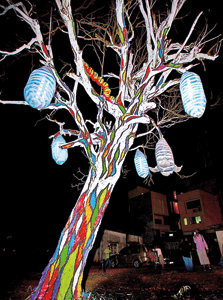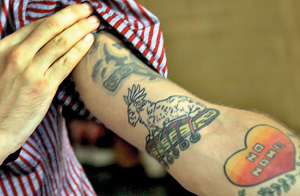It keeps recurring – this conviction that I’m trapped in a comic book with my interviewee, a German who goes by the moniker ‘Nomad’. Taken anecdote by anecdote, the life of this Berlin-based street artist could easily be shaped to fit some alternate superhero myth. Consider all that flitting about Berlin by night and the “armour” created by his numerous tattoos.
 |
| Demi Moore |
Then there’s the picture he likes to send to accompany his C.V – his face bruised and bleeding after an altercation with Nazi skinheads. There’s the fact that he’s lived on the streets, and took his name from the ramblings of a philosophical Polish boy under a bridge somewhere in Paris and that in his career he’s always had to stay one step ahead of the law. It’s the somewhat startling integrity he brings to his artistic vision. It’s that I don’t know what his real name is...And then, as if to put the finishing touch on the tale, there’s Demi Moore.
The tattoo of the spotted dog eating its tail on his right forearm was meant to remind Nomad of the relatively significant month he spent with Demi and her husband Ashton Kutcher in L.A. The two “kidnapped/adopted” the artist. It turns out that they’re fans of his, so much so that Demi wanted to buy Ashton an original Nomad for Valentines.
“I was surprised by how many photographs of my work Ashton already had,” Nomad says, patently more impressed by Kutcher’s “niceness” than his fame. His celebrity fan base, which incidentally is said to include actress Salma Hayek, would probably surprise anyone who has followed the arc of Nomad’s career. If his exhibitions have a defining characteristic, it could be his determination to make his art both affordable and accessible.
When we meet, Nomad promptly establishes his bona fides as a one-time sound engineer and DJ by untangling my Dictaphone mike’s wire and then demonstrating how I can always keep it neatly coiled. When the interview finally gets underway, Nomad reveals that he first picked up a spray can at the tender age of 16 in the company of some of his skateboarding friends. Inspired by hip hop, hard punk, and the rave culture of the 80’s he quickly became a master “writer” (so dubbed because graffiti as an art form is more akin to calligraphy than graphic design.) “Graffiti,” he says is rooted in the moment when “you take over a superhero character and you become this character, writing this superhero alias on walls.”
Eventually, he would choose to “decode” his writing, he explains, describing his shift into writing poetry and creating illustrations to accompany them. Unlike the graffiti artist whose skill and message was likely to be appreciated only by others in his tribe, this new work was increasingly designed to be something the public at large could appreciate.
He would dedicate seven years to one project, going out only at night to paint up to 30 pieces of garbage with the image of a character he had created called Mr. Friendly. Come morning, people would find Mr. Friendly decorating castoff appliances, broken windows, wooden boards and garbage cans and a dozen other surfaces besides. Much of what could be picked up easily was immediately claimed by fans – Nomad once met a man who transported a 200 kilo water boiler into his apartment along with 30 other Mr. Friendly pieces. What was unclaimed, the artist was happy to leave in the tender care of the municipality’s garbage disposal unit.
In another project Nomad locked himself into a gallery for 24 hours and proceeded to paint every available surface including the floor. When the gallery opened, people could come in and select any portion to be tattooed onto their bodies – the demand was overwhelming and many had to be turned away, Nomad recalls. (In keeping with his philosophy, one of his many tattoos commemorates that project: “I think tattoos should be reminders, they should have meaning for you. They can be like an armour, an armour of good thoughts.”)
 |
| Art in public spaces: The tree on Galle Road decorated by Nomad’s proteges |
Throughout his work has continued to be whimsical, provocative and often wildly inventive –from inviting gift boxes strewn across ruins to paintings that cover the sides of entire buildings “I had to basically work with everything – anything I could find,” he says remembering. “You become very versatile, you learn how to look for materials while you’re riding down a street on a bike. You create this kind of scanning view, you can imagine, ‘I could built this with that or connect that with that’.”
Nomad came by his dexterity with different tools honestly. He attributes it to growing up in a working class family and “learning during my childhood from my dad who built most of his house with his own hands and maintains it with his own hands.” His mother, a fashion designer, balanced things out, bringing in colour and fun. His father’s son, Nomad says he doesn’t like delegating, and so out of necessity he’s learnt how to work with different tools and different mediums.
His honest work ethics haven’t kept him from being misunderstood, though. He says he’s had “countless” brushes with the law and paid over 12,000 euros in fines. Ironically, it’s given him credibility, and when street art became the fad in Berlin it brought big galleries knocking at his door. “I had to learn from scratch how an artist has to defend his work,” says Nomad, “I never went to art school. I just did what I did and at some point people considered that art.” It was harder work than he makes it sound. With no space to work in and no money to work with, it was hard to even to put together an initial exhibition – it didn’t help that he didn’t particularly want to become a favourite with rich collectors.
“I don’t see what I’m doing as something that should be sold for millions of dollars,” he says, explaining that he considers the art market mostly silly. “It’s like the stock market. It’s complete insanity. I don’t want to be part of that. I want to make art for the people and not so that some rich millionaire can sit on it.”
 |
| Much tattooed: Nomad (above left) and his decorated arm. Pix by M.A. Pushpa Kumara |
It’s this approach that led the Goethe Institut in Colombo to invite Nomad to mentor the artists who were a part of their ‘Art Needs Space’ programme. Project Manager, Annoushka Hempel knew that local artists were struggling with a real lack of exhibition spaces and believed that Nomad was just the person to help take CoCA (the collective title adopted by the artists in the programme) out on to the streets. “They needed someone hands on,” she says, “someone who would get out there with them.”
Out of his month-long stay, the group created only two projects – one installation in a tree on the grounds of the Sri Lanka Foundation Institute (SLFI) and the other also a tree off Galle Road (if you’re going from Bambalapitiya to Colpetty, it’s behind the second bus halt). Noticeably, both are on private property. Their dream of commandeering public spaces got bogged down in bureaucratic red tape.
Annoushka and Nomad concede that it was frustrating and disappointing, but both seem to believe as strongly in the need to see art be given more space in Colombo’s urban spaces. “I want them to keep up believing in their work in public,” says Nomad of his young protégées. “Your first responsibility as an artist is not your pocket or your purse but to the society you live in. You are in a very powerful position and a privileged position as well to change people’s ways of thinking.” |




